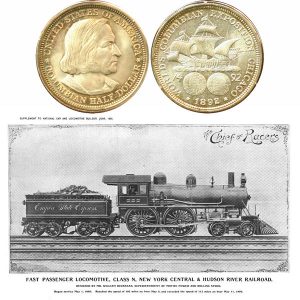Today, the World’s Columbian Exposition Commemorative Silver Half Dollar Coin remembers when Engine 999 achieved 112.5 miles per hour between Rochester and Buffalo on May 11, 1893.
This engine shortly afterwards became a display at the World’s Columbian Exposition in Chicago.
From the periodical National Car and Locomotive Builder of June 1893:
=====
The Empire State Express Locomotive.—No. 999
The imposing appearance and harmonious outlines of this handsome engine would be sufficient justification in themselves to warrant our giving liberal space to their illustration and description.
But the old saying that “Beauty is as beauty does” never received a more prompt fulfillment of its implied requisition that beauty should do well than in the case of this engine; which before the paint was hardly dry upon it was placed on exhibition in the Grand Central Station at New York City and was the object of admiration, and doubtless the inspiration of awe in many thousands of visitors, and which before it had run a thousand miles broke the world’s record of fast train speeds and exceeded a speed of 100 miles an hour.
This unprecedented feat was accomplished on May 9 while hauling the Empire State Express between New York and Buffalo, going west.
Because of the water in the boiler foaming badly 25 minutes were lost east of Syracuse. That station was left 23 minutes late. The train left Rochester at 4:15 p. m., 2 minutes late, and made the run from Rochester to Buffalo, 69 miles, in 68 minutes. The five miles between Looneyville and Grimesville were covered in three and a half minutes, at the average rate of a mile in 42 seconds, or at the rate of 85.9 miles per hour.
One mile between Grimesville and the Forks was covered in 35 seconds, or at the rate of 102.8 miles per hour.
The time was kept by officers of the road who were on the train with stop watches.
The road at this point is level, and some of the remarkable features of the performance are that it was done after the engine had hauled its train some 400 miles, and, therefore, after the condition of its fire had become unsuitable for the most rapid combustion and generation of heat.
The sustained run of 69 miles in 68 minutes was made after the engine had hauled the train 371 miles; the run of five miles, at 85.9 miles an hour, was made after a run of 424 miles, and the mile at 102.8 miles an hour after 429 miles had been run.
The total mileage that this new engine had made in service up to this time was but 800 miles.
Those familiar with new locomotives know how stiffly they handle and run for the first four or five thousand miles of their service, until all the internal and external moving parts have had their rubbing services receive the higher polish and more perfect fit that service in contact alone can give:
The weight of the train hauled during this performance was as follows:
Buffet car – 79,000 lbs
Drawing-room car – 94,950 lbs
Two coaches – 156,000 lbs
Total – 329,950 lbs
The weight of the engine and tender in running order is 204,000 lbs., making the total weight of the engine and train on this occasion 533,950 lbs. Mr. Charles Hogan was the engineer in charge.
The highest previously recorded locomotive speed was the 97.3 miles per hour attained by the Baldwin compound locomotive No. 385, of the Central Railroad of New Jersey, on Nov. 18, 1892. This run was described and commented on in the December, 1892, issue of the National Car and Locomotive Builder; and the engine was illustrated and described in our issue for February, 1893.
On May 11, while hauling the Empire State Express again, bound west, as before, Engine 999, like Wordsworth’s “Happy Warrior:”
“Who, not content that former worth stands fast,
Looks forward, persevering to the last
From well to better, daily self-surpassed,”
surpassed its previous record-breaking performance and annihilated space at the rate of 112.5 miles per hour.
After the train left Rochester, on this occasion, the engineer, Charles Hogan, allowed a little time to be lost.
Passing Batavia the train was running along at an easy gait of a mile a minute. The speed was increased, an just before reaching Crittenden the record of May 5 of a mile in thirty-five seconds was equaled.
But this was exceeded just west of that station, when a mile was run in 32 seconds. This is equivalent to 112.5, miles an hour.
Unlike the previous run of a mile in 35 seconds, which as before stated, was made on a level stretch of road, this run was made on a descending grade of 15 feet per mile.
We have the assurance of the officers of the New York Central, among them Mr. William Buchanan, that this run was made as here reported.
The engine is the first of a new class of engines (Class N) designed by Mr. William Buchanan, Superintendent of Motive Power and Rolling Stock, and built at the New York Central’s shops at West Albany.
…
This engine will shortly be sent to Chicago, where it will be on exhibition during the summer.
=====
The World’s Columbian Exposition Commemorative Silver Half Dollar Coin shows with an artist’s image of Engine 999.
